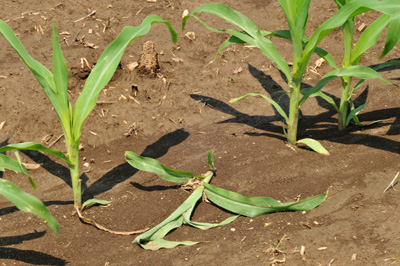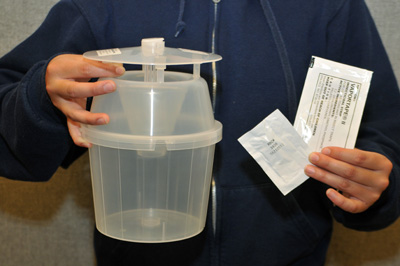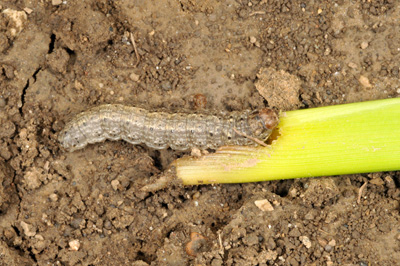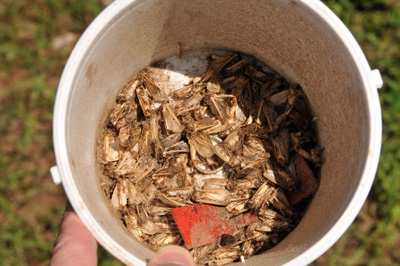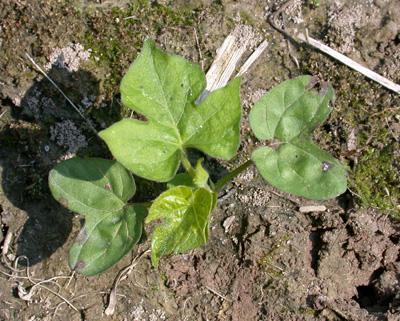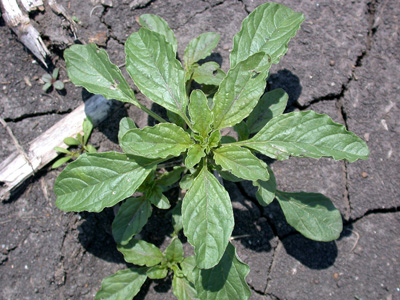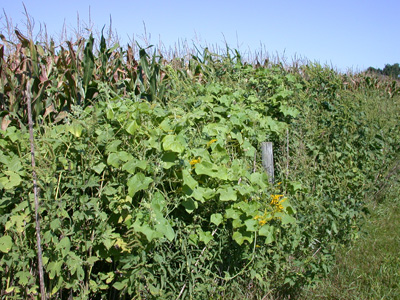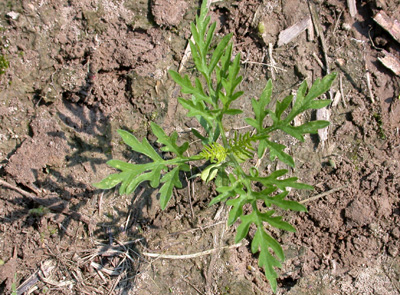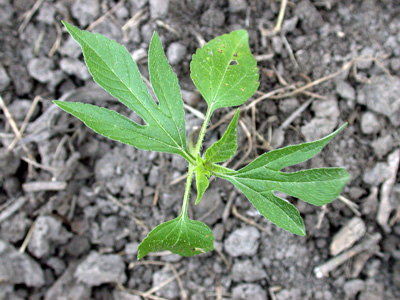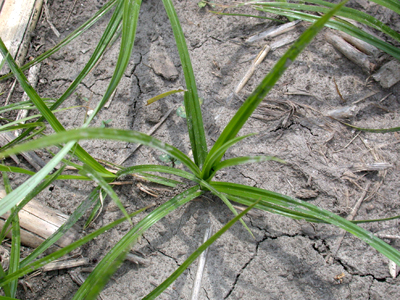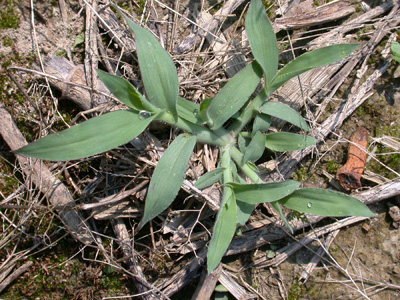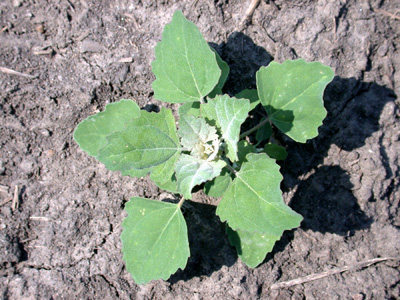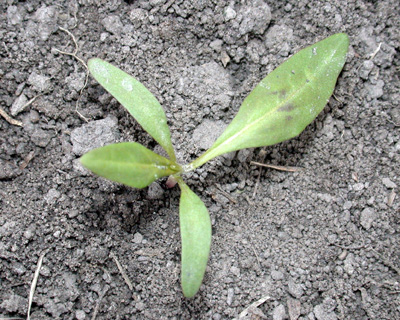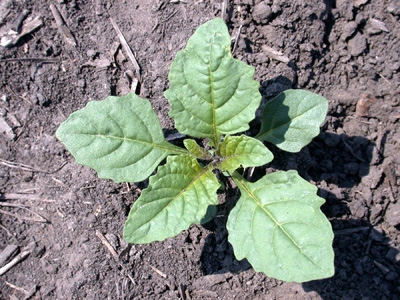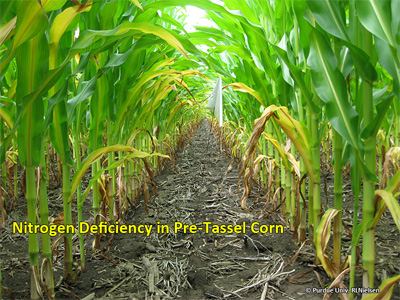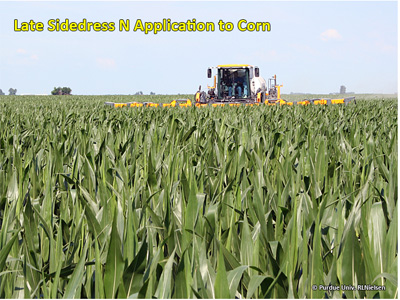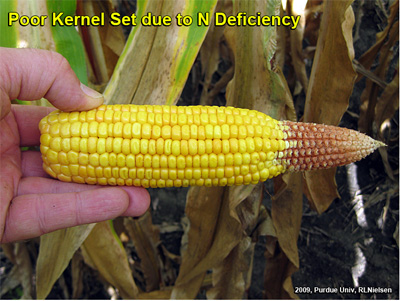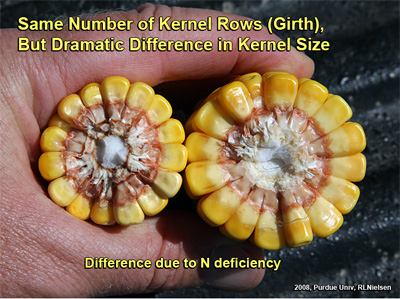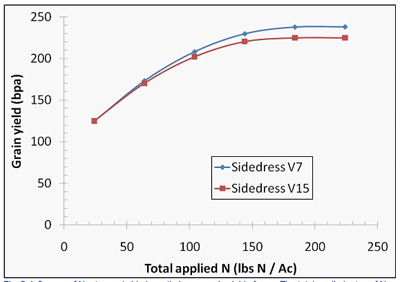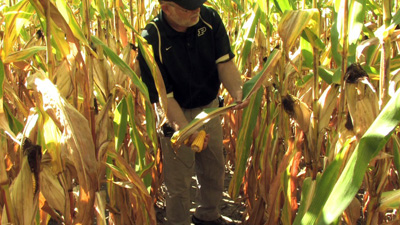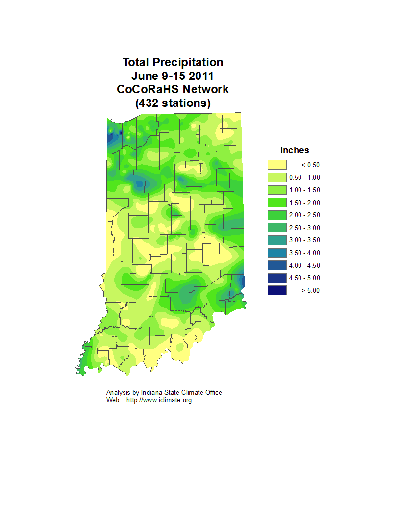Next Cutworm to Watch For: Western Bean Cutworm – (Christian Krupke and John Obermeyer)
• The last of the largest black cutworm larvae are bringing down “big” corn.
• WBC monitoring for emerging moths begins next week (June 20th)
• Traps and other supplies can still be ordered in time to get into the game!
Amazingly, we are still getting reports of V4-5 leaf cornfields being damaged by black cutworm larvae. The large larvae, those that soon will pupate, are tunneling up into the corn stalks from below the ground. As producers have been out applying nitrogen, they’ve seen plants lying over, and under closer inspection, subsequent poor plant populations. Unfortunately there is nothing that can be done at this late date – treatments are not very effective and the damage has been done.
Downed corn by black cutworm tunneling
Beginning next week, our pheromone trap cooperators will begin monitoring for the western bean cutworm. Unlike the black cutworm, which migrates here as an adult moth in the spring, this species overwinters as a mature larva deep in the soil profile to escape freezing temperatures. Early in the spring these caterpillars begin to pupate, and sometime in mid-to late June (probably later this year, due to a cold spring), begin to emerge as moths. Moth emergence and flight will continue for several weeks, with the peak sometime in mid to late July. Trap catches will be our best guide to where this species has overwintered in abundance. However, they are not a reliable indicator of pressure levels – just because a field catches half the moths of a neighbor does not mean they will see half the damage. Watch future issues of the Pest&Crop as we report the trapper’s catches.
Want to do your own trapping? It’s not too late to order your supplies in order to monitor for this insect’s presence/abundance for your area. We recommend a clear or green universal (bucket) trap. With that you will need 2 pheromone lures (replace the first one after 3 weeks), specific for western bean cutworm, and a vapor strip (“kill” strip) placed inside the trap to keep the captured moths from flying out when you open the top for counting. The whole outfit will cost about $16.00/trap, depending on how many you order. We order our supplies from Great Lakes IPM, their contact information is as follows: www.greatlakesipm.com, glipm@greatlakesipm.com, or 989-268-5693. Gemplers also carries IPM supplies: www.gemplers.com, 800-383-8473. This is just informational, and not meant to be an endorsement or advertisement.
Supplies needed for western bean cutworm moth trapping
Feasting black cutworm soon to be pupating
A 2010 trapper's one-night's catch
![]()
Click here to see the Black Light Trap Catch Report
![]()
A Few Thoughts on Postemergence Herbicide Applications – (Tom Jordan, Bill Johnson, and Glenn Nice)
To get the most out of a postemergence herbicide application, timing for weed height is critical. Most herbicide labels state that broadleaf weeds should be no more than 4 to 6 inches tall and grasses even smaller. That does not mean that you cannot spray taller weeds and be successful, but the taller the weed gets over label recommendation, the less the performance will be to your liking. Small weeds are easier to cover with an herbicide spray and their cuticles are thinner. Thus, more herbicide enters the plant. The taller the weed the less coverage you get, and the hotter and drier the conditions, the thicker the plant cuticles will be; thus the less efficacy you will get. Herbicide application timing is not always convenient to achieve, and some of the later emerging weeds may not fit the niche for a one-time postemergence application. You end up with some weeds being too tall, some not emerged, and some just right for the application. Did you ever wonder why an 18 inch to two foot or taller giant ragweed plant was so hard to control (let’s not mention three to four feet tall)? The only way you got one that tall was to first have one three or four inches tall. The control of the small ones will always be greater than that of the taller ones.
In a year like this one, where heavy rains are sure to produce a multitude of late emerging weeds, it is imperative that scouting is done to identify individual weed species as they emerge and select the correct herbicide to control them. This may mean that you will need to make an additional application on a timely bases before the corn or beans are over the growth stage needed to ensure crop safety while catching the weeds at a small enough stage to get maximum weed control.
Timing for crop height is as critical as timing for weed height with postemergence herbicides when it comes to products like the plant growth regulators such as 2,4-D or dicamba and related herbicides or with amino acid inhibitor herbicides like the SU’s and related products. Consider an area of about three square feet. When a corn plant is only about four inches tall, it occupies only a small portion of the area and the crop plant intercepts only a small fraction of the spray solution that covers that area. As the plant grows it occupied a much larger portion of the area and thus intercepts a higher quantity of the spray solution. These types of translocated herbicides move to the newly developing plant tissue in the crop plant. If brace roots are being developed, then an over application of a growth regulator herbicide can cause brace root damage. If the plant is three feet or taller it can act like a funnel and collect the spray solution directing it to the whorl of the plant where the newly developing tissue is likely to be the developing tassel or ear, where it could cause malformed tassels and or deformed ears.
Years in which crops are delayed due to heavy rains and flooding creates a difficult situation for weed control due to a number of weeds that would normally not be a problem in a field becoming more of a dominate problem. These weed will invariably germinate when you least want them to do so, causing your application timing to be off. Effort is needed to time postemergence herbicide application to control late emerging weeds while they are small and likewise not spray crop plants that are taller than the label recommends. Sometime this may call for drop nozzles.
![]()
The Dirty Bakers’ Dozen Weeds – (Bill Johnson, Glenn Nice, and Tom Jordan)
In a year like we have been experiencing, where heavy rains have delayed planting and the preemergence herbicides have been under pressure, we will in all likelihood see a number of weeds emerge in both corn and soybean fields. Some of the more common weeds that emerge late when preemergence herbicides have been subjected to heavy rains and particularly the grass component of the program has been weakened are:
- Morningglories
- Waterhemp
- Burcucumber
- Fall panicum
- Common Ragweed
- Giant Ragweed
- Yellow Nutsedge
- Shattercane
- Crabgrass
- Lambsquarters
- Smartweeds
- Nightshades
- Barnyardgrass
Ivy leaf morningglory
Waterhemp
Burcucumber in fence line
Common ragweed
Giant ragweed
Nutsedge
Crabgrass
Lambsquarters
Smartweed
Nightshade
Several of these weeds not only emerge later in the season than our common weed populations, but they will also have multiple flushes throughout the first half of the growing season following each rain occurrence. A single application, or even a second application of glyphosate or Ignite may not be enough to control some of these weeds. Depending on the weed population mix in an individual field, additional herbicide choices may be needed to control these herbicides. There is a large choice of postemergence herbicides labeled for these weeds, but care is needed to make the right choice, and timing for weed height and corn growth stage in critical to make these herbicides work. This just may be the year to scout field for later emerging weeds and study the efficacy tables in the Weed Control Guide <http://www.btny.purdue.edu/Pubs/WS/WS-16/> to select the proper herbicide that can control these late weeds. Sometime the application can be mixed with a standard post application, but this may be the year that an additional trip across the field is needed.
![]()
Prevalence and Influence of Stalk Boring Insects on Glyphosate Activity on Indiana and Michigan Giant Ragweed – (Bill Johnson, Corey Gerber, John Obermeyer, and Glenn Nice)
This article is a summary of a scientific study we published in the journal Weed Technology in 2007. If you want to read the leaded, full bodied version, see this citation: Ott, E. J., C. K. Gerber, D. B. Harder, C. L. Sprague, and W. G. Johnson. 2007. Prevalence and influence of stalk boring insects on glyphosate activity on Indiana and Michigan giant ragweed (Ambrosia trifida). Weed Technol. 21:526-531.
Introduction
Giant ragweed (GRW) plants have been shown to serve as a host to stalk boring insects (SBIs) such as the European corn borer (ECB), the stalk borer, the celery leaftier, the cocklebur weevil, the ragweed borer, and a longhorn beetle. In addition, we receive many questions regarding the influence of SBIs on glyphosate activity as well as the biology of SBIs that utilize GRW as a host. The objectives of this article is to report on some of the previous work we have done to 1) determine the prevalence, distribution and identity of SBIs in GRW at various times during the growing season in Indiana and Michigan, and 2) determine the influence of ECB, giant ragweed size, glyphosate rate, and spray carrier volume on GRW control with glyphosate under greenhouse conditions.
Materials and Methods
Field Survey. Four regions in Indiana (northeast, northwest, central, and southwest), and three regions in Michigan (central, southeast, and southwest) were surveyed once in August 2004 and once in June, August, and September of 2005. In each region, five random soybean fields where GRW plants were present at the time of sampling were selected arbitrarily for observations. In June 2005, five GRW plants 1-foot tall, and five GRW plants larger than 1 foot (up to 2 foot tall) were collected from each field and dissected to determine if SBIs or SBI tunnels were present. During the mid-August and mid-September sampling time, ten GRW plants protruding above the soybean canopy were arbitrarily collected from each field. Individual plant heights were recorded, and a visual subjective assessment was made regarding whether or not the GRW plant had escaped control with glyphosate. These plants were also dissected to determine if SBIs or SBI tunnels were present. During each of the sampling times, if SBIs were found, the insects were collected and preserved in vials containing 70% isopropyl alcohol. Insect specimens were identified with a dissecting microscope to the family level.
Greenhouse Study. GRW seedlings (1- to 2-inches tall) were collected from the Purdue University Agronomy Center for Research and Education near West Lafayette, Indiana and transplanted into pots with growth media. Pots were placed in the greenhouse under supplemental lights. When GRW plants were 4-inches tall, 2 to 4 newly hatched ECB larvae were placed on designated plants. The plants were sprayed with glyphosate when they were either 6- or 18-inches tall with various glyphosate rates (0, 0.38, 0.75, or1.5 lb ae/A), and spray carrier volumes (10 or 20 GPA). Ammonium sulfate was included in each glyphosate treatment. At 21 days after glyphosate treatment, all GRW plants were dissected to confirm ECB tunneling in the desired plants, and dried before dry weights were recorded.
Results and Discussion
Prevalence of SBIs and Tunneling in GRW. In August 2004, SBI tunneling was observed in 66 to 79% of the GRW plants examined in Indiana, and 35 to 64% of GRW plants examined in Michigan (Table 1). In June 2005, SBIs and tunneling were observed in 10 to 26% of all GRW plants examined in Indiana and 4 to 30% of all GRW plants examined in Michigan. In August 2005, 54 to 88% of Indiana GRW plants and 48 to 70% of Michigan GRW plants exhibited SBI tunneling. In September 2005, 76 to 94% of all GRW plants examined in Indiana contained SBI tunneling, whereas 64 to 74% of all GRW plants sampled in Michigan contained SBI tunneling. During the August and September sample times, SBIs were found in 8 to 42% of the plants with SBI tunnels, suggesting that the SBIs previously present in GRW stems had completed larval development, pupated and emerged as adults from the GRW plants. Overall, insect tunneling and infestation levels were similar in both states in June. Slightly higher percentages of GRW plants contained insect tunnels in Indiana during the August and September surveys as compared to Michigan. Throughout the growing season, six SBI families were identified, three families from the order Coleoptera, and three families from the order Lepidoptera.
Frequency of Late-Season GRW Escapes with SBIs or SBI Tunneling. The percentage of GRW plants that survived a herbicide application and contained SBIs and/or SBI tunnels ranged from 28 to 40% in Indiana in August 2004 (Table 2). In Michigan during this same sample time, only 5 to 31% of GRW plants displayed herbicide injury and contained evidence of SBIs and/or SBI tunneling. Based on surveys, in August 2005, 28 to 62% of GRW escaped herbicide application in Indiana and contained evidence of SBI activity (Table 2). Higher percentages of GRW plants with SBI tunnels survived a herbicide application in 5 out of 8 regions in 2004 and 5 out of 5 regions in 2005.
Greenhouse study. Glyphosate efficacy on 6-inch tall GRW plants was enhanced by ECB activity at the 0.38 and 0.75 lb ae/A rate at both carrier volumes (Table 3). This occurrence is likely due to the following reason. The glyphosate treatments to 6-inch GRW were applied 5 to 7 days after the ECB were placed on the plants, at which time the plants were under considerable stress from the initial boring of the ECB into the small plant stems. Glyphosate efficacy at the 1.5 lb ae/A rate was not influenced by ECB activity. Results from the control of 18-inch plants did not show significant carrier volume effects. Glyphosate efficacy was reduced by the presence of ECB activity on 18-inch tall plants at the 0.38 and 0.75 lb ae/A rate (Table 2), but not at the 1.5 lb ae/A rate. Glyphosate had little effect on 18-inch tall plants with ECB activity at the 0.33 lb ae/A rate. On 18-inch tall plants, utilization of the 0.75 or 1.5 lb ae/A rates provided better control than the 0.38 lb ae/A rate.
In summary, multiple insect families were found to utilize GRW plants as a host during the time window when the initial postemergence glyphosate applications were being made to soybeans in June of 2005. Although our survey did not determine if SBIs infested GRW before or after initial glyphosate applications were made, the possibility of SBI’s having a negative influence on glyphosate efficacy is plausible based on the results of our greenhouse study. Five different insect families were identified at the August sample times and is likely that they infest GRW after the initial postemergence glyphosate applications. However, they may have infested GRW before rescue sprays were made in July. Control failures with July applications could be due to a number of causes including environmental factors, inadequate rates for the large plants typically present during this spray timing, poor spray coverage of lower leaves due to the soybean canopy, and the high percentage of plants which contain SBIs and/or SBI tunnels.
![]()
![]()
Response of Corn to Late-season Nitrogen Application - (Eric Miller, Bob Nielsen, and Jim Camberato)
Nitrogen (N) fertilizer is a crucial input for maximizing yield and profitability of corn. The expense and environmental impact of N fertilizer has heightened the need for efficient N management practices. A sidedress application of N fertilizer is one option to improve N use efficiency by reducing the risk of N loss prior to plant uptake. However, wet field conditions during times of planned sidedress applications can seriously delay the timing of the application. Thus a concern arises as to the impact of later-applied N on corn yield, profit, and fertilizer N efficiency. In the Eastern Corn Belt, little research has been conducted on the consequences of delayed N application on corn yield and profitability or environmental impacts.
l
Nitrogen deficiency in pre-tassel corn
In 2010, we initiated a 13-acre field-scale experiment at the Pinney-Purdue Agricultural Center near Wanatah, Indiana to address these questions. The previous crop was soybean. The trial was planted on April 22 directly following cultivation resulting in an ideal seedbed, excellent seed to soil contact, and good seed germination. Seedlings emerged uniformly and plants developed uniformly throughout the growing season. All plots received an initial 24 lbs N/acre as starter fertilizer during planting.
In this trial, 28% urea-ammonium nitrate was sidedressed at either V7 (defined by 7 visible leaf collars) or V15 growth stages at 0, 40, 80, 120, 160, and 200 lbs actual N/acre. The late N application was intended to occur at V12, but weather and an equipment malfunction delayed the application until V15. A traditional knife injection tool bar was utilized at V7, whereas a Hagie® high clearance sprayer with a mounted coulter-injection toolbar was used at V15. During the 14 days preceding the V15 application, over four inches of rain were recorded at the weather station near this field. However, significant rainfall did not occur until 11 days after the V15 N application.
Late sideress N application to corn
At silking, total above-ground dry matter and N content was the same whether the corn had received only starter N or starter N plus 200 lbs/ac N at V15. Nitrogen stress was obvious in both treatments with leaves fired up to the ear. The fact that little rainfall had occurred between the V15 application and silking undoubtedly contributed to the lack of response to the extra N by this point in time. Not until four weeks after silking (R4 stage – kernel dough stage) did the corn show evidence of responding to the N applied at V15 in terms of increased aboveground biomass accumulation when compared to the starter-only control.
Total number of ovules (pollinated or not) were counted at growth stage R2 (kernel blister stage). These numbers reflect the potential number of kernels. The number of potential kernels was similar between the V15 and starter-only treatments (Fig. 1). However, potential kernel numbers for both of these treatments were approximately 9% fewer than the V7 treatment. At this point, 20 days after the V15 sidedress application, the V15 sidedress plots showed no visual differences versus plots that received only starter fertilizer.
At physiological maturity, the number of harvestable kernels for the V15 sidedress treatment was only 6% less than for the V7 sidedress treatment, but 28% greater than for the starter-only control (Fig. 1). Kernel weights were nearly identical for the V7 and V15 sidedress treatments. One can conclude that the yield differences among these sidedress treatments were due to a combination of effects that occurred during ear size determination and on kernel survival during grain fill.
At harvest, the V15 sidedressed plots yielded 100 bu/acre more than the starter-only control and only 13 bu/acre less than the traditional V7 sidedress timing (Fig. 2). Most of the 13 bu/acre difference in grain yield between the two sidedress timings was due to differences in kernel number per ear at harvest (Fig 1). The agronomic optimum N rates for the two sidedress timings were similar (188 vs 178 for V7 and V15, respectively).
Poor kernel set due to N deficiency
Same number of kernel rows (Girth), but dramatic difference in kernel size
In 2007, a similar study was conducted at the same location with similar results. Nitrogen fertilizer sidedress-applied at growth stage V13 increased yield 64 bu/acre compared to the starter-only control, but yield was 18 bu/acre less than an earlier V3 sidedress treatment (Emmert, 2009). In both studies, corn plants were visibly N deficient but otherwise healthy due to excellent growing conditions throughout the season. Good uniform stands, healthy plants and established root systems likely contributed to the substantial benefit of N fertilizer applied late in the season.
The results of these studies demonstrate that corn can recover from significant N deficiency stress with applications of sidedress N fertilizer even as late as V13 to V15. In a year when weather can delay field work into unconventional periods of the growing season, options still remain to recover significant yield with late sidedress N applications.
The caveat to these promising results is that when N deficiency occurs due to saturated soils and ponding of fields, the resulting stands of corn are often also compromised due to root damage caused by the excessive soil moisture. Under these more challenging conditions, corn may not respond as strongly to late applied N. Consequently, previous recommendations from Purdue suggested no more than 60 lbs N/acre be applied to severely N deficient corn late during the vegetative period (Brouder and Mengel, 2003).
Figure 1. Influence of timing and rate of N fertilizer on yield component of corn. Starter-only treatments consisted of 24 lbs N/ac. Sidedress rates were in addition to 24 lbs N/ac applied as started at planting. Pinney-Purdue Ag Cemter, 2011.
Figure 2. Influence of N rates and sidedress timing on grain yield of corn. The total applied rates of N included 24 lbs N/ac applied as started at planting (left-most data point represents only starter fertilizer). Pinney-Purdue Ag Center, 2011.
One last comment we would make regarding sidedress application equipment for late growth stages is that while our trial used a high-clearance applicator equipped with a mounted coulter-injection toolbar, similar high-clearance applicators equipped with drop nozzles could also be used with minimal risk of N loss by volatilization within a closed crop canopy. One should take care to weight the drop nozzles to minimize their swaying and bouncing and, thus, minimize the amount of liquid N splashed on plant tissue that would cause significant leaf damage. Dribbling liquid N on the soil surface in this manner would also be more dependent on soil moisture or subsequent rainfall to move the N into the soil for plant uptake.
Related References
Brouder, S.M. , and D.B. Mengel. 2003. Determining nitrogen fertilizer sidedress application needs in corn using a chlorophyll meter. Purdue Univ. Extension publication AY-317_W. Online at <http://www.agry.purdue.edu/ext/pubs/AY-317-W.pdf> [URL accessed June 2011].
Camberato, Jim, RL (Bob) Nielsen, and Brad Joern. 2011. Assessing Available Nitrogen from Fall- and Spring-Applied Nitrogen Applications. Corny News Network, Purdue Univ. Extension. Online at <http://www.kingcorn.org/news/timeless/AssessAvailableN.html>. [URL accessed June 2011].
Camberato, Jim, RL (Bob) Nielsen, Eric Miller, and Brad Joern. 2011. Nitrogen Management Guidelines for Indiana. Purdue Univ. Extension Applied Crop Research Update. Online at <http://www.kingcorn.org/news/timeless/NitrogenMgmt.pdf> [URL accessed June 2011].
Emmert, D. 2009. Using canopy reflectance to monitor corn response to nitrogen and the effects of delayed nitrogen application. Master’s Thesis. Purdue University.
Scharf, Peter. 2009. Nitrogen Loss: Again??!! Univ. of Missouri Integrated Pest & Crop Management Newsletter. Online at <http://ppp.missouri.edu/newsletters/ipcm/archives/fullissue/v19n13.pdf> [URL accessed June 2011].
Thomison, Peter and Robert Mullen. 2010. “Late” Applications of Nitrogen to Corn. Ohio State Univ. Extension C.O.R.N. Newsletter. Online at <http://agcrops.osu.edu/corn/newsletters/2010/2010-17/late-applications-of-nitrogen-to-corn> [URL accessed June 2011].
Bob Nielsen inspecting nitrogen deficient corn plot
![]()

